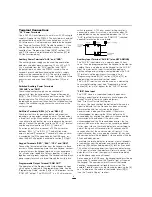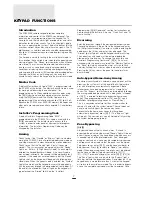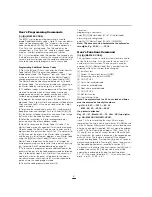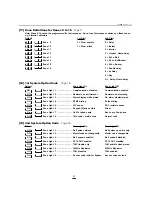
18
programmed for fast
6 = 24 Hour buzzer
response - Do not use
7 = Double delay
fast response devices
8 = 4 X Delay
on these zones.
9 = Day
e.g. vibration detector.
A = Delay Home-Away
[18] 1st System Option Code
The 1st system option code is set using the zone lights to
indicate which options in the following list are active. Once
Section [18] is entered the 8 zone lights will indicate which
options are active. Press the corresponding number key to
turn an option on or off. Press [0] to turn all options off.
[1] Light off= Communications enabled
Light on =
Communications disabled
[2] Light off= Zone restorals transmitted on disarming
(This is a form of swinger shuntdown)
Light on= Zone restorals transmitted on bell time out
[3] Light off= No alarms are displayed while panel is armed
Light on= Alarms are displayed on keypad zone LED’s
while panel is armed
[4] Light off= Panel dials pulse. (rotary dialing)
Light on= Panel dials DTMF. (touch tone dialing)
[5] Light off= Zones 1 to 16 use end-of-line-resistor
Light on= Zones 1 to 16 use normally closed zones
[6] Light off= Keypad panic [P] bell is silent
Light on= Keypad panic [P] bell is audible
(See Keypad Zones page 11)
[7] Light off= Call 1st phone with backup to 2nd phone
Light on= Becomes 1st phone number only
(Do not program backup to 2nd phone number if no 2nd
phone number is programmed)
(See section [33] page 22)
[8] Light off= 16th code becomes normal access code
Light on= 16th code is maid's code (One Time Use
code)
(See [
Q
] [5] “User Programming Commands” page 8)
[19] 2nd System Option Code
Use same method of programming as used in section [18].
[1] Light off= Bell responds normally
Light on= Bell pulses always
(Bell will pulse for alarm or fire if enabled)
[2] Light off= Master Code changeable by user
Light on= Master Code changeable by installer only
(See [
Q
] [5] “User Programming Commands” page 8)
[3] Light off= Disable bell squawk when arm/disarm
Light on= Enable bell squawk when arm/disarm
(1 burst on Arm/2 bursts on Disarm)
[4] Light off= PC16OUT module disabled
Light on= PC16OUT module enabled
Module which provides 16 voltage outputs indicating
panel conditions. See distributor for details.
[5] Light off= TLM trouble, audible bell when armed
Light on= TLM trouble only, armed or disarmed
(TLM = Telephone Line Monitoring)
[6] Light off= Accepts 2300 Hz (standard) handshake
Light on= Accepts 1400 Hz handshake for Radionics
formats #3, 4, B and C in section
[27]
(See Radionics format description page 20).
[7] Light off= Enable Telephone Line Monitoring (TLM)
Light on= Disable Telephone Line Monitoring (TLM)
[8] Light off= No access code required for zone bypassing
Light on= Use [
Q
]+[1]+[Access Code] for zone
bypassing (shunting)
[20] Zones 1 to 8 Bypass Mask
Use the same method of programming as used in section
[18]. Using this section it is possible to control which zones
the user is able to bypass using the [
Q
][1] command. If the
zone light is on the zone can be bypassed. If the zone light
is off that zone cannot be bypassed.
[21] Zones 9 to 16 Bypass Mask
Use same method of programming as used in section [20].
Note: Zone lights 1 to 8 represent zones 9 to 16 in this
section, to allow single digit entry.
[22] System Times
Once the section number is entered, 6 two digit numbers
are expected to be entered. The valid range for entries in
this section is 01 to 99. Hex values or 00 are not allowed.
The times are entered in the following order:
• Entry delay time (in seconds)
• Exit delay time (in seconds)
• Bell cut off time (in minutes)
• Delay before AC failure trouble reporting (in minutes)
• Slow zone response time (in 10 ms increments)
Default zone response - 500 ms
• Test transmission/periodic download cycle time (in days)
AC Failure Reporting Code
is transmitted after a delay,
which may be 99 minutes, programmed. The reporting code
for AC Failure Trouble is programmed in sections [12] and
[13].
The Zone Response Time
is the length of time that an
alarm condition must be present on a zone before it is
detected. Certain vibration detectors, shock sensors and
glass break detectors require a fast response zone in order
to operate. The zones to which these types of detectors are
connected should be programmed as fast response zones.
All other zones should be programmed as slow response
zones. Zones are defined as either fast or slow response
time in Section [16]. The fast response time is fixed at 10
milliseconds. The Slow Zone Response Time is
programmable in increments of 10 milliseconds. The normal
entry would be 50 for a 500 ms slow response time.
A Test Transmission or a Periodic Download
may be
done according to how section [49] light 8 is set. The test
Summary of Contents for PC3OOO
Page 1: ...INSTALLATION MANUAL PC3OOO Version 7 51...
Page 40: ...HOOKUP DIAGRAMS 36...
Page 44: ...29000543 R7...
















































